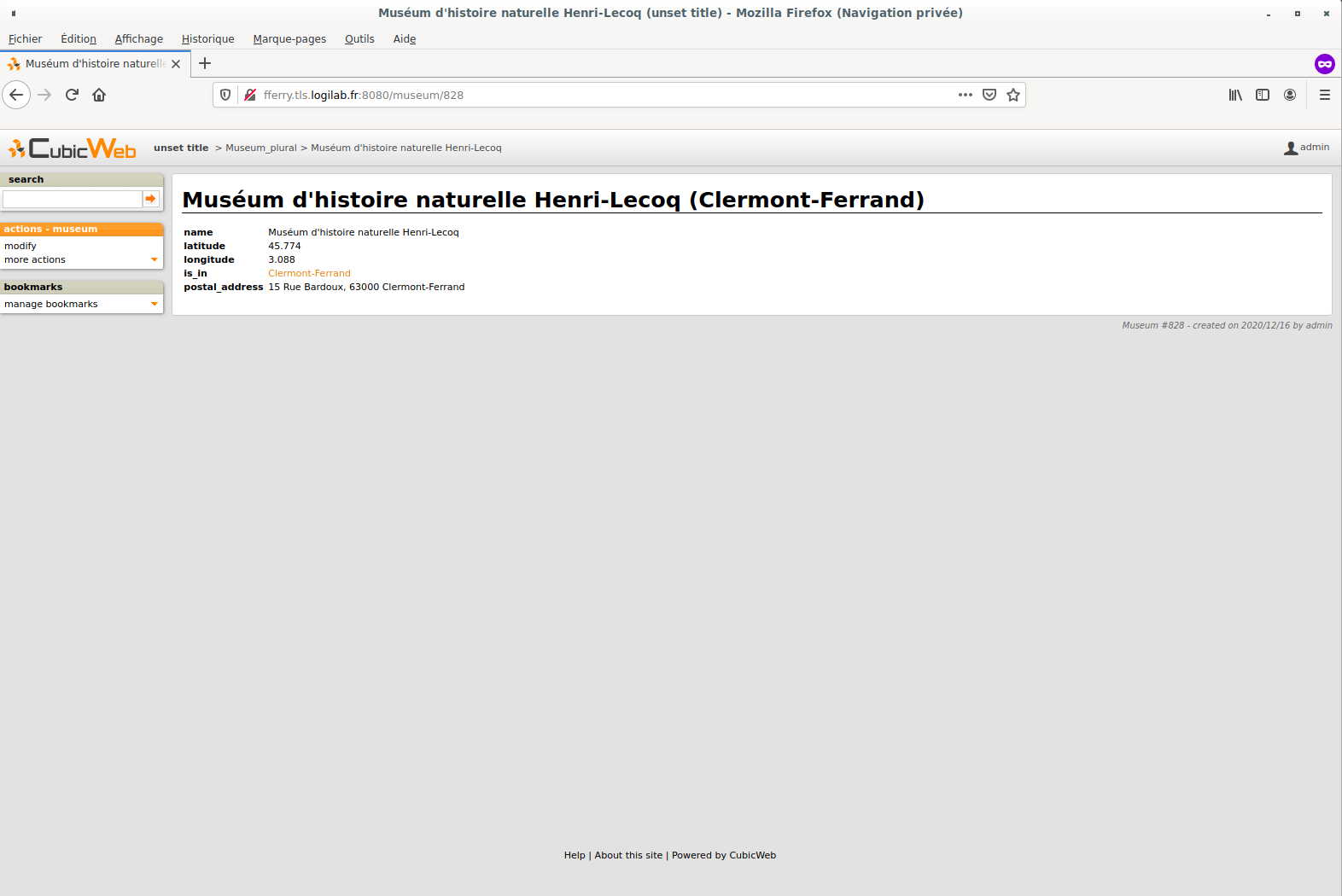Developping the user interface#
Customize museum primary view#
The ‘primary’ view (i.e. any view with the identifier set to ‘primary’) is the one used to display all the information about a single entity. The standard primary view is one of the most sophisticated views of all. It has several customisation points, but its power comes with uicfg, allowing you to control it without having to subclass it. More information are available here : The Primary View.
Now we have several museums, we want an easier way to identify its city when we are on the
museum page. To achieve this, we will subclass PrimaryView and override render_entity_title
method in tuto/cubicweb_tuto/views.py:
from cubicweb.predicates import is_instance
from cubicweb_web.views.primary import PrimaryView
class MuseumPrimaryView(PrimaryView):
__select__ = is_instance("Museum")
def render_entity_title(self, entity):
"""Renders the entity title.
"""
city_name = entity.is_in[0].name
self.w(f"<h1>{entity.name} ({city_name})</h1>")
As stated before, CubicWeb comes with a system of views selection. This system is, among other things, based on selectors declared with __select__ (you’ll find more information about this in the Registries and application objects chapter). As we want to customize museum primary view, we use __select__ = is_instance(“Museum”) to tell CubicWeb this is only applicable when we display a Museum entity.
Then, we just override the method used to compute title to add the city name. To reach the city name, we use the relation is_in and choose the first and only one linked city, then ask for its name.

Use entities.py to add more logic#
CubicWeb provides an ORM to easily programmaticaly manipulate
entities. By default, entity types are instances of the AnyEntity class,
which holds a set of predefined methods as well as property automatically generated for
attributes/relations of the type it represents.
You can redefine each entity to provide additional methods or whatever you want to help you write your application. Customizing an entity requires that your entity:
inherits from
cubicweb.entities.AnyEntityor any subclassdefines a
__regid__linked to the corresponding data type of your schema
You may then want to add your own methods, override default implementation of some method, etc…
As we may want reuse our custom museum title (with city name, as defined in previous section), we will define it as a property of our Museum class.
To do so, write this code in tuto/cubicweb_tuto/entities.py:
from cubicweb.entities import AnyEntity, fetch_config
class Museum(AnyEntity):
__regid__ = "Museum"
@property
def title_with_city(self):
return f"{self.name} ({self.is_in[0].name})"
Then, we just have to use it our previously defined view in tuto/cubicweb_tuto/views.py:
from cubicweb.predicates import is_instance
from cubicweb_web.views.primary import PrimaryView
class MuseumPrimaryView(PrimaryView):
__select__ = is_instance("Museum")
def render_entity_title(self, entity):
"""Renders the entity title.
"""
self.w(f"<h1>{entity.title_with_city}</h1>")
Conclusion#
In this first part, we laid the cornerstone of our futur site, and discovered some core functionalities of CubicWeb. In next parts, we will improve views and see how to import all our data.